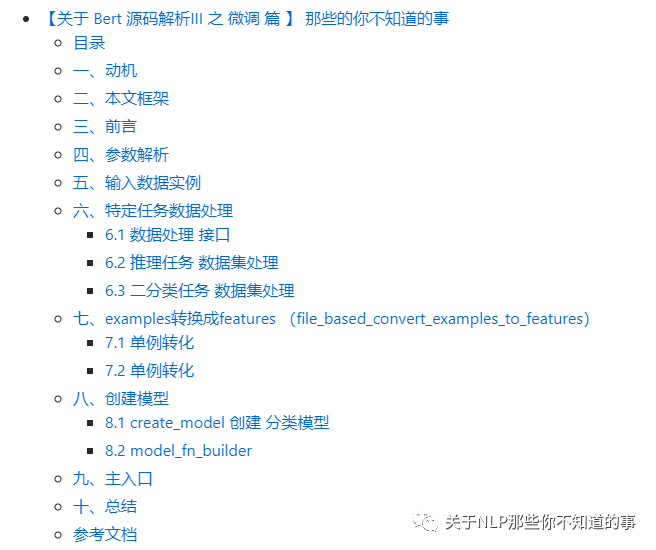作者:杨夕
论文链接:https://arxiv.org/pdf/1810.04805.pdf
本文链接:https://github.com/km1994/nlp_paper_study
个人介绍:大佬们好,我叫杨夕,该项目主要是本人在研读顶会论文和复现经典论文过程中,所见、所思、所想、所闻,可能存在一些理解错误,希望大佬们多多指正。
【注:手机阅读可能图片打不开!!!】
目录

一、动机
之前给 小伙伴们 写过 一篇 【【关于Bert】 那些的你不知道的事】后,有一些小伙伴联系我,说对 【Bert】 里面的很多细节性问题都没看懂,不清楚他怎么实现的。针对该问题,小菜鸡的我 也 意识到自己的不足,所以就 想 研读一下 【Bert】 的 源码,并针对 之前小伙伴 的一些 问题 进行 回答和解释,能力有限,希望对大家有帮助。
二、本文框架
本文 将 【Bert】 的 源码分成以下模块:
【关于 Bert 源码解析 之 主体篇 】 那些的你不知道的事
【关于 Bert 源码解析 之 预训练篇 】 那些的你不知道的事
【关于 Bert 源码解析 之 微调篇 】 那些的你不知道的事【本章】
【关于 Bert 源码解析IV 之 句向量生成篇 】 那些的你不知道的事
【关于 Bert 源码解析V 之 文本相似度篇 】 那些的你不知道的事
分模块 进行解读。
三、前言
本文 主要 解读 Bert 模型的 微调 模块代码:
run_classifier.py:主要用于 文本分类 任务的微调
四、参数解析
flags = tf.flags
FLAGS = flags.FLAGS
'''
必要参数
'''
# 数据地址
flags.DEFINE_string(
"data_dir", None,
"The input data dir. Should contain the .tsv files (or other data files) "
"for the task.")
# Bert 配置文件地址
flags.DEFINE_string(
"bert_config_file", None,
"The config json file corresponding to the pre-trained BERT model. "
"This specifies the model architecture.")
# 训练任务
flags.DEFINE_string("task_name", None, "The name of the task to train.")
# Bert 词库
flags.DEFINE_string("vocab_file", None,
"The vocabulary file that the BERT model was trained on.")
# 训练输出 地址
flags.DEFINE_string(
"output_dir", None,
"The output directory where the model checkpoints will be written.")
'''
其他参数
'''
# 预训练 Bert 模型
flags.DEFINE_string(
"init_checkpoint", None,
"Initial checkpoint (usually from a pre-trained BERT model).")
# 是否小写
flags.DEFINE_bool(
"do_lower_case", True,
"Whether to lower case the input text. Should be True for uncased "
"models and False for cased models.")
# 指定WordPiece tokenization 之后的sequence的最大长度,要求小于等于预训练模型的最大sequence长度。当输入的数据长度小于max_seq_length时用0补齐,如果长度大于max_seq_length则truncate处理;
flags.DEFINE_integer(
"max_seq_length", 128,
"The maximum total input sequence length after WordPiece tokenization. "
"Sequences longer than this will be truncated, and sequences shorter "
"than this will be padded.")
# 训练
flags.DEFINE_bool("do_train", False, "Whether to run training.")
# 验证
flags.DEFINE_bool("do_eval", False, "Whether to run eval on the dev set.")
# 预测
flags.DEFINE_bool(
"do_predict", False,
"Whether to run the model in inference mode on the test set.")
# 训练 Batch 大小
flags.DEFINE_integer("train_batch_size", 32, "Total batch size for training.")
# 评测 Batch 大小
flags.DEFINE_integer("eval_batch_size", 8, "Total batch size for eval.")
# 预测 Batch 大小
flags.DEFINE_integer("predict_batch_size", 8, "Total batch size for predict.")
# 学习率
flags.DEFINE_float("learning_rate", 5e-5, "The initial learning rate for Adam.")
# 训练 epochs
flags.DEFINE_float("num_train_epochs", 3.0,
"Total number of training epochs to perform.")
# 进行线性学习率预热的训练比例。
flags.DEFINE_float(
"warmup_proportion", 0.1,
"Proportion of training to perform linear learning rate warmup for. "
"E.g., 0.1 = 10% of training.")
# 保存模型 步长
flags.DEFINE_integer("save_checkpoints_steps", 1000,
"How often to save the model checkpoint.")
# 每个 estimator call 调用中要执行多少步
flags.DEFINE_integer("iterations_per_loop", 1000,
"How many steps to make in each estimator call.")
# 是否 使用 TPU
flags.DEFINE_bool("use_tpu", False, "Whether to use TPU or GPU/CPU.")
# TPU 名称
tf.flags.DEFINE_string(
"tpu_name", None,
"The Cloud TPU to use for training. This should be either the name "
"used when creating the Cloud TPU, or a grpc://ip.address.of.tpu:8470 "
"url.")
tf.flags.DEFINE_string(
"tpu_zone", None,
"[Optional] GCE zone where the Cloud TPU is located in. If not "
"specified, we will attempt to automatically detect the GCE project from "
"metadata.")
tf.flags.DEFINE_string(
"gcp_project", None,
"[Optional] Project name for the Cloud TPU-enabled project. If not "
"specified, we will attempt to automatically detect the GCE project from "
"metadata.")
tf.flags.DEFINE_string("master", None, "[Optional] TensorFlow master URL.")
flags.DEFINE_integer(
"num_tpu_cores", 8,
"Only used if `use_tpu` is True. Total number of TPU cores to use.")
五、输入数据实例
class InputExample(object):
"""A single training/test example for simple sequence classification."""
def __init__(self, guid, text_a, text_b=None, label=None):
"""Constructs a InputExample.
Args:
guid: 实例 唯一 id
text_a: string. 第一个序列的未标记文本。 对于单序列任务,仅必须指定此序列。
text_b: (Optional) string. 第二个序列的未标记文本。 仅必须为序列对任务指定。
label: (Optional) string. 实例的标签。 应该为train和dev实例指定此名称,但不为测试实例指定,如果是test数据集则label统一为0。
"""
self.guid = guid
self.text_a = text_a
self.text_b = text_b
self.label = label
六、特定任务数据处理
6.1 数据处理 接口
作用:数据预处理 接口
class DataProcessor(object):
"""Base class for data converters for sequence classification data sets."""
def get_train_examples(self, data_dir):
"""Gets a collection of `InputExample`s for the train set."""
raise NotImplementedError()
def get_dev_examples(self, data_dir):
"""Gets a collection of `InputExample`s for the dev set."""
raise NotImplementedError()
def get_test_examples(self, data_dir):
"""Gets a collection of `InputExample`s for prediction."""
raise NotImplementedError()
def get_labels(self):
"""Gets the list of labels for this data set."""
raise NotImplementedError()
@classmethod
def _read_tsv(cls, input_file, quotechar=None):
"""Reads a tab separated value file."""
with tf.gfile.Open(input_file, "r") as f:
reader = csv.reader(f, delimiter="\t", quotechar=quotechar)
lines = []
for line in reader:
lines.append(line)
return lines
6.2 推理任务 数据集处理
目标:读取两句话,并判定两者间的关系是否为“蕴含”(Entailment)、“矛盾”(Contradict)或“中性”(Neutral)
具体任务数据介绍:FAIR重磅发布大规模语料库XNLI:支持15种语言,解决跨语言理解难题
class XnliProcessor(DataProcessor):
"""Processor for the XNLI data set."""
def __init__(self):
self.language = "zh"
def get_train_examples(self, data_dir):
"""See base class."""
lines = self._read_tsv(
os.path.join(data_dir, "multinli",
"multinli.train.%s.tsv" % self.language))
examples = []
for (i, line) in enumerate(lines):
if i == 0:
continue
guid = "train-%d" % (i)
text_a = tokenization.convert_to_unicode(line[0])
text_b = tokenization.convert_to_unicode(line[1])
label = tokenization.convert_to_unicode(line[2])
if label == tokenization.convert_to_unicode("contradictory"):
label = tokenization.convert_to_unicode("contradiction")
examples.append(
InputExample(guid=guid, text_a=text_a, text_b=text_b, label=label))
return examples
def get_dev_examples(self, data_dir):
"""See base class."""
lines = self._read_tsv(os.path.join(data_dir, "xnli.dev.tsv"))
examples = []
for (i, line) in enumerate(lines):
if i == 0:
continue
guid = "dev-%d" % (i)
language = tokenization.convert_to_unicode(line[0])
if language != tokenization.convert_to_unicode(self.language):
continue
text_a = tokenization.convert_to_unicode(line[6])
text_b = tokenization.convert_to_unicode(line[7])
label = tokenization.convert_to_unicode(line[1])
examples.append(
InputExample(guid=guid, text_a=text_a, text_b=text_b, label=label))
return examples
def get_labels(self):
"""See base class."""
return ["contradiction", "entailment", "neutral"]
6.3 二分类任务 数据集处理
class ColaProcessor(DataProcessor):
"""Processor for the CoLA data set (GLUE version)."""
def get_train_examples(self, data_dir):
"""See base class."""
return self._create_examples(
self._read_tsv(os.path.join(data_dir, "train.tsv")), "train")
def get_dev_examples(self, data_dir):
"""See base class."""
return self._create_examples(
self._read_tsv(os.path.join(data_dir, "dev.tsv")), "dev")
def get_test_examples(self, data_dir):
"""See base class."""
return self._create_examples(
self._read_tsv(os.path.join(data_dir, "test.tsv")), "test")
def get_labels(self):
"""See base class."""
return ["0", "1"]
def _create_examples(self, lines, set_type):
"""Creates examples for the training and dev sets."""
examples = []
for (i, line) in enumerate(lines):
# Only the test set has a header
if set_type == "test" and i == 0:
continue
guid = "%s-%s" % (set_type, i)
if set_type == "test":
text_a = tokenization.convert_to_unicode(line[1])
label = "0"
else:
text_a = tokenization.convert_to_unicode(line[3])
label = tokenization.convert_to_unicode(line[1])
examples.append(
InputExample(guid=guid, text_a=text_a, text_b=None, label=label))
return examples
七、examples转换成features (file_based_convert_examples_to_features)
7.1 单例转化
作用:将单个InputExample转换为单个InputFeatures。
流程:
step 1:判断 example 是否是 PaddingInputExample
step 2:构建 label map
step 3:text_a 序列化
step 4:text_b 序列化
step 5:训练 长度修改
step 6:输入数据 转化未 Bert 所要求类型数据
step 7:输入数据 转化为 id 系列
step 8:Mask 数据
step 9:利用 0 填充
step 10:标签 处理
step 11:构建 InputExample
def convert_single_example(
ex_index,
example,
label_list,
max_seq_length,
tokenizer):
"""将单个 InputExample 转换为单个InputFeatures。"""
# step 1:判断 example 是否是 PaddingInputExample
if isinstance(example, PaddingInputExample):
return InputFeatures(
input_ids=[0] * max_seq_length,
input_mask=[0] * max_seq_length,
segment_ids=[0] * max_seq_length,
label_id=0,
is_real_example=False)
# step 2:构建 label map
label_map = {}
for (i, label) in enumerate(label_list):
label_map[label] = i
# step 3:text_a 序列化
tokens_a = tokenizer.tokenize(example.text_a)
# step 4:text_b 序列化
tokens_b = None
if example.text_b:
tokens_b = tokenizer.tokenize(example.text_b)
# step 5:训练 长度修改
if tokens_b:
# 在适当位置修改`tokens_a`和`tokens_b`,以使总长度小于指定长度。
# Account for [CLS], [SEP], [SEP] with "- 3"
_truncate_seq_pair(tokens_a, tokens_b, max_seq_length - 3)
else:
# Account for [CLS] and [SEP] with "- 2"
if len(tokens_a) > max_seq_length - 2:
tokens_a = tokens_a[0:(max_seq_length - 2)]
# step 6:输入数据 转化未 Bert 所要求类型数据
# The convention in BERT is:
# (a) For sequence pairs:
# tokens: [CLS] is this jack ##son ##ville ? [SEP] no it is not . [SEP]
# type_ids: 0 0 0 0 0 0 0 0 1 1 1 1 1 1
# (b) For single sequences:
# tokens: [CLS] the dog is hairy . [SEP]
# type_ids: 0 0 0 0 0 0 0
#
# Where "type_ids" are used to indicate whether this is the first sequence or the second sequence. The embedding vectors for `type=0` and `type=1` were learned during pre-training and are added to the wordpiece embedding vector (and position vector). This is not *strictly* necessary since the [SEP] token unambiguously separates the sequences, but it makes it easier for the model to learn the concept of sequences.
#
# For classification tasks, the first vector (corresponding to [CLS]) is used as the "sentence vector". Note that this only makes sense because the entire model is fine-tuned.
tokens = []
segment_ids = []
tokens.append("[CLS]")
segment_ids.append(0)
for token in tokens_a:
tokens.append(token)
segment_ids.append(0)
tokens.append("[SEP]")
segment_ids.append(0)
if tokens_b:
for token in tokens_b:
tokens.append(token)
segment_ids.append(1)
tokens.append("[SEP]")
segment_ids.append(1)
# step 7:输入数据 转化为 id 系列
input_ids = tokenizer.convert_tokens_to_ids(tokens)
# step 8:Mask 数据
# The mask has 1 for real tokens and 0 for padding tokens. Only real
# tokens are attended to.
input_mask = [1] * len(input_ids)
# step 9:利用 0 填充
# Zero-pad up to the sequence length.
while len(input_ids) < max_seq_length:
input_ids.append(0)
input_mask.append(0)
segment_ids.append(0)
assert len(input_ids) == max_seq_length
assert len(input_mask) == max_seq_length
assert len(segment_ids) == max_seq_length
# step 10:标签 处理
label_id = label_map[example.label]
if ex_index < 5:
tf.logging.info("*** Example ***")
tf.logging.info("guid: %s" % (example.guid))
tf.logging.info("tokens: %s" % " ".join(
[tokenization.printable_text(x) for x in tokens]))
tf.logging.info("input_ids: %s" % " ".join([str(x) for x in input_ids]))
tf.logging.info("input_mask: %s" % " ".join([str(x) for x in input_mask]))
tf.logging.info("segment_ids: %s" % " ".join([str(x) for x in segment_ids]))
tf.logging.info("label: %s (id = %d)" % (example.label, label_id))
# step 11:构建 InputFeatures 实例
feature = InputFeatures(
input_ids=input_ids,
input_mask=input_mask,
segment_ids=segment_ids,
label_id=label_id,
is_real_example=True)
return feature
7.2 单例转化
def file_based_convert_examples_to_features(
examples, label_list, max_seq_length, tokenizer, output_file):
"""Convert a set of `InputExample`s to a TFRecord file."""
writer = tf.python_io.TFRecordWriter(output_file)
for (ex_index, example) in enumerate(examples):
if ex_index % 10000 == 0:
tf.logging.info("Writing example %d of %d" % (ex_index, len(examples)))
feature = convert_single_example(ex_index, example, label_list,
max_seq_length, tokenizer)
def create_int_feature(values):
f = tf.train.Feature(int64_list=tf.train.Int64List(value=list(values)))
return f
features = collections.OrderedDict()
features["input_ids"] = create_int_feature(feature.input_ids)
features["input_mask"] = create_int_feature(feature.input_mask)
features["segment_ids"] = create_int_feature(feature.segment_ids)
features["label_ids"] = create_int_feature([feature.label_id])
features["is_real_example"] = create_int_feature(
[int(feature.is_real_example)])
tf_example = tf.train.Example(features=tf.train.Features(feature=features))
writer.write(tf_example.SerializeToString())
writer.close()
八、创建模型
8.1 create_model 创建 分类模型
def create_model(bert_config, is_training, input_ids, input_mask, segment_ids,
labels, num_labels, use_one_hot_embeddings):
"""创建 分类模型"""
model = modeling.BertModel(
config=bert_config,
is_training=is_training,
input_ids=input_ids,
input_mask=input_mask,
token_type_ids=segment_ids,
use_one_hot_embeddings=use_one_hot_embeddings)
# In the demo, we are doing a simple classification task on the entire segment.
#
# If you want to use the token-level output, use model.get_sequence_output() instead.
output_layer = model.get_pooled_output()
hidden_size = output_layer.shape[-1].value
output_weights = tf.get_variable(
"output_weights", [num_labels, hidden_size],
initializer=tf.truncated_normal_initializer(stddev=0.02))
output_bias = tf.get_variable(
"output_bias", [num_labels], initializer=tf.zeros_initializer())
# 计算损失函数
with tf.variable_scope("loss"):
if is_training:
# I.e., 0.1 dropout
output_layer = tf.nn.dropout(output_layer, keep_prob=0.9)
logits = tf.matmul(output_layer, output_weights, transpose_b=True)
logits = tf.nn.bias_add(logits, output_bias)
probabilities = tf.nn.softmax(logits, axis=-1)
log_probs = tf.nn.log_softmax(logits, axis=-1)
one_hot_labels = tf.one_hot(labels, depth=num_labels, dtype=tf.float32)
per_example_loss = -tf.reduce_sum(one_hot_labels * log_probs, axis=-1)
loss = tf.reduce_mean(per_example_loss)
return (loss, per_example_loss, logits, probabilities)
8.2 model_fn_builder
作用:
def model_fn_builder(bert_config, num_labels, init_checkpoint, learning_rate,
num_train_steps, num_warmup_steps, use_tpu,
use_one_hot_embeddings):
"""Returns `model_fn` closure for TPUEstimator."""
def model_fn(features, labels, mode, params): # pylint: disable=unused-argument
"""The `model_fn` for TPUEstimator."""
tf.logging.info("*** Features ***")
for name in sorted(features.keys()):
tf.logging.info(" name = %s, shape = %s" % (name, features[name].shape))
input_ids = features["input_ids"]
input_mask = features["input_mask"]
segment_ids = features["segment_ids"]
label_ids = features["label_ids"]
is_real_example = None
if "is_real_example" in features:
is_real_example = tf.cast(features["is_real_example"], dtype=tf.float32)
else:
is_real_example = tf.ones(tf.shape(label_ids), dtype=tf.float32)
is_training = (mode == tf.estimator.ModeKeys.TRAIN)
# 总的损失定义为两者之和
(total_loss, per_example_loss, logits, probabilities) = create_model(
bert_config, is_training, input_ids, input_mask, segment_ids, label_ids,
num_labels, use_one_hot_embeddings)
# 获取所有变量
tvars = tf.trainable_variables()
initialized_variable_names = {}
scaffold_fn = None
# 如果有之前保存的模型,则进行恢复
if init_checkpoint:
(assignment_map, initialized_variable_names
) = modeling.get_assignment_map_from_checkpoint(tvars, init_checkpoint)
if use_tpu:
def tpu_scaffold():
tf.train.init_from_checkpoint(init_checkpoint, assignment_map)
return tf.train.Scaffold()
scaffold_fn = tpu_scaffold
else:
tf.train.init_from_checkpoint(init_checkpoint, assignment_map)
tf.logging.info("**** Trainable Variables ****")
for var in tvars:
init_string = ""
if var.name in initialized_variable_names:
init_string = ", *INIT_FROM_CKPT*"
tf.logging.info(" name = %s, shape = %s%s", var.name, var.shape,
init_string)
# 训练过程,获得spec
output_spec = None
if mode == tf.estimator.ModeKeys.TRAIN:
train_op = optimization.create_optimizer(
total_loss, learning_rate, num_train_steps, num_warmup_steps, use_tpu)
output_spec = tf.contrib.tpu.TPUEstimatorSpec(
mode=mode,
loss=total_loss,
train_op=train_op,
scaffold_fn=scaffold_fn)
# 验证过程spec
elif mode == tf.estimator.ModeKeys.EVAL:
def metric_fn(per_example_loss, label_ids, logits, is_real_example):
predictions = tf.argmax(logits, axis=-1, output_type=tf.int32)
accuracy = tf.metrics.accuracy(
labels=label_ids, predictions=predictions, weights=is_real_example)
loss = tf.metrics.mean(values=per_example_loss, weights=is_real_example)
return {
"eval_accuracy": accuracy,
"eval_loss": loss,
}
eval_metrics = (metric_fn,
[per_example_loss, label_ids, logits, is_real_example])
output_spec = tf.contrib.tpu.TPUEstimatorSpec(
mode=mode,
loss=total_loss,
eval_metrics=eval_metrics,
scaffold_fn=scaffold_fn)
# 预测过程spec
else:
output_spec = tf.contrib.tpu.TPUEstimatorSpec(
mode=mode,
predictions={"probabilities": probabilities},
scaffold_fn=scaffold_fn)
return output_spec
return model_fn
九、主入口
def main(_):
tf.logging.set_verbosity(tf.logging.INFO)
# 任务处理器 映射表
processors = {
"cola": ColaProcessor,
"mnli": MnliProcessor,
"mrpc": MrpcProcessor,
"xnli": XnliProcessor,
}
tokenization.validate_case_matches_checkpoint(FLAGS.do_lower_case,
FLAGS.init_checkpoint)
if not FLAGS.do_train and not FLAGS.do_eval and not FLAGS.do_predict:
raise ValueError(
"At least one of `do_train`, `do_eval` or `do_predict' must be True.")
# 加载 Bert 配置
bert_config = modeling.BertConfig.from_json_file(FLAGS.bert_config_file)
if FLAGS.max_seq_length > bert_config.max_position_embeddings:
raise ValueError(
"Cannot use sequence length %d because the BERT model "
"was only trained up to sequence length %d" %
(FLAGS.max_seq_length, bert_config.max_position_embeddings))
tf.gfile.MakeDirs(FLAGS.output_dir)
task_name = FLAGS.task_name.lower()
if task_name not in processors:
raise ValueError("Task not found: %s" % (task_name))
# 定义任务处理器
processor = processors[task_name]()
# 获取标签项
label_list = processor.get_labels()
# 数据预处理
tokenizer = tokenization.FullTokenizer(
vocab_file=FLAGS.vocab_file, do_lower_case=FLAGS.do_lower_case)
tpu_cluster_resolver = None
if FLAGS.use_tpu and FLAGS.tpu_name:
tpu_cluster_resolver = tf.contrib.cluster_resolver.TPUClusterResolver(
FLAGS.tpu_name, zone=FLAGS.tpu_zone, project=FLAGS.gcp_project)
is_per_host = tf.contrib.tpu.InputPipelineConfig.PER_HOST_V2
run_config = tf.contrib.tpu.RunConfig(
cluster=tpu_cluster_resolver,
master=FLAGS.master,
model_dir=FLAGS.output_dir,
save_checkpoints_steps=FLAGS.save_checkpoints_steps,
tpu_config=tf.contrib.tpu.TPUConfig(
iterations_per_loop=FLAGS.iterations_per_loop,
num_shards=FLAGS.num_tpu_cores,
per_host_input_for_training=is_per_host))
train_examples = None
num_train_steps = None
num_warmup_steps = None
# 模型训练 数据加载
if FLAGS.do_train:
# 加载训练数据
train_examples = processor.get_train_examples(FLAGS.data_dir)
num_train_steps = int(
len(train_examples) / FLAGS.train_batch_size * FLAGS.num_train_epochs)
num_warmup_steps = int(num_train_steps * FLAGS.warmup_proportion)
# 自定义模型用于estimator训练
model_fn = model_fn_builder(
bert_config=bert_config,
num_labels=len(label_list),
init_checkpoint=FLAGS.init_checkpoint,
learning_rate=FLAGS.learning_rate,
num_train_steps=num_train_steps,
num_warmup_steps=num_warmup_steps,
use_tpu=FLAGS.use_tpu,
use_one_hot_embeddings=FLAGS.use_tpu)
# 如果没有TPU,会自动转为CPU/GPU的Estimator
estimator = tf.contrib.tpu.TPUEstimator(
use_tpu=FLAGS.use_tpu,
model_fn=model_fn,
config=run_config,
train_batch_size=FLAGS.train_batch_size,
eval_batch_size=FLAGS.eval_batch_size,
predict_batch_size=FLAGS.predict_batch_size)
# 模型 训练
if FLAGS.do_train:
train_file = os.path.join(FLAGS.output_dir, "train.tf_record")
file_based_convert_examples_to_features(
train_examples, label_list, FLAGS.max_seq_length, tokenizer, train_file)
tf.logging.info("***** Running training *****")
tf.logging.info(" Num examples = %d", len(train_examples))
tf.logging.info(" Batch size = %d", FLAGS.train_batch_size)
tf.logging.info(" Num steps = %d", num_train_steps)
train_input_fn = file_based_input_fn_builder(
input_file=train_file,
seq_length=FLAGS.max_seq_length,
is_training=True,
drop_remainder=True)
estimator.train(input_fn=train_input_fn, max_steps=num_train_steps)
# 模型 验证 数据加载
if FLAGS.do_eval:
eval_examples = processor.get_dev_examples(FLAGS.data_dir)
num_actual_eval_examples = len(eval_examples)
if FLAGS.use_tpu:
# TPU requires a fixed batch size for all batches, therefore the number
# of examples must be a multiple of the batch size, or else examples
# will get dropped. So we pad with fake examples which are ignored
# later on. These do NOT count towards the metric (all tf.metrics
# support a per-instance weight, and these get a weight of 0.0).
while len(eval_examples) % FLAGS.eval_batch_size != 0:
eval_examples.append(PaddingInputExample())
eval_file = os.path.join(FLAGS.output_dir, "eval.tf_record")
file_based_convert_examples_to_features(
eval_examples, label_list, FLAGS.max_seq_length, tokenizer, eval_file)
tf.logging.info("***** Running evaluation *****")
tf.logging.info(" Num examples = %d (%d actual, %d padding)",
len(eval_examples), num_actual_eval_examples,
len(eval_examples) - num_actual_eval_examples)
tf.logging.info(" Batch size = %d", FLAGS.eval_batch_size)
# This tells the estimator to run through the entire set.
eval_steps = None
# However, if running eval on the TPU, you will need to specify the
# number of steps.
if FLAGS.use_tpu:
assert len(eval_examples) % FLAGS.eval_batch_size == 0
eval_steps = int(len(eval_examples) // FLAGS.eval_batch_size)
eval_drop_remainder = True if FLAGS.use_tpu else False
eval_input_fn = file_based_input_fn_builder(
input_file=eval_file,
seq_length=FLAGS.max_seq_length,
is_training=False,
drop_remainder=eval_drop_remainder)
result = estimator.evaluate(input_fn=eval_input_fn, steps=eval_steps)
output_eval_file = os.path.join(FLAGS.output_dir, "eval_results.txt")
with tf.gfile.GFile(output_eval_file, "w") as writer:
tf.logging.info("***** Eval results *****")
for key in sorted(result.keys()):
tf.logging.info(" %s = %s", key, str(result[key]))
writer.write("%s = %s\n" % (key, str(result[key])))
# 模型预测
if FLAGS.do_predict:
predict_examples = processor.get_test_examples(FLAGS.data_dir)
num_actual_predict_examples = len(predict_examples)
if FLAGS.use_tpu:
# TPU requires a fixed batch size for all batches, therefore the number
# of examples must be a multiple of the batch size, or else examples
# will get dropped. So we pad with fake examples which are ignored
# later on.
while len(predict_examples) % FLAGS.predict_batch_size != 0:
predict_examples.append(PaddingInputExample())
predict_file = os.path.join(FLAGS.output_dir, "predict.tf_record")
file_based_convert_examples_to_features(predict_examples, label_list,
FLAGS.max_seq_length, tokenizer,
predict_file)
tf.logging.info("***** Running prediction*****")
tf.logging.info(" Num examples = %d (%d actual, %d padding)",
len(predict_examples), num_actual_predict_examples,
len(predict_examples) - num_actual_predict_examples)
tf.logging.info(" Batch size = %d", FLAGS.predict_batch_size)
predict_drop_remainder = True if FLAGS.use_tpu else False
predict_input_fn = file_based_input_fn_builder(
input_file=predict_file,
seq_length=FLAGS.max_seq_length,
is_training=False,
drop_remainder=predict_drop_remainder)
result = estimator.predict(input_fn=predict_input_fn)
output_predict_file = os.path.join(FLAGS.output_dir, "test_results.tsv")
with tf.gfile.GFile(output_predict_file, "w") as writer:
num_written_lines = 0
tf.logging.info("***** Predict results *****")
for (i, prediction) in enumerate(result):
probabilities = prediction["probabilities"]
if i >= num_actual_predict_examples:
break
output_line = "\t".join(
str(class_probability)
for class_probability in probabilities) + "\n"
writer.write(output_line)
num_written_lines += 1
assert num_written_lines == num_actual_predict_examples
十、总结
本章 主要介绍了 利用 Bert fineturn,代码比较简单。
【关于 Bert 源码解析 之 主体篇 】 那些的你不知道的事
【关于 Bert 源码解析 之 预训练篇 】 那些的你不知道的事
【关于 Bert 源码解析 之 微调篇 】 那些的你不知道的事【本章】
【关于 Bert 源码解析IV 之 句向量生成篇 】 那些的你不知道的事
【关于 Bert 源码解析V 之 文本相似度篇 】 那些的你不知道的事
分模块 进行解读。
参考文档
Bert系列(四)——源码解读之Fine-tune
BERT源码分析PART III








